Scenarios let you assign conditions that determine which shipping methods are displayed to your customers at checkout. Scenarios can also be used to apply product filters that determine which products are included in the final shipping calculation.
Shipping methods within a Scenario will only be displayed at checkout when Scenario conditions have been met.
Scenarios are where shipping methods reside, so you’ll need to set up at least one even if you don’t have any conditions.
Add A Scenario
1) Click Shipping on the sidebar menu, then select Scenarios from the drop-down list.

2) Click the Create scenario button.

General Settings
1) Enter a Scenario title.
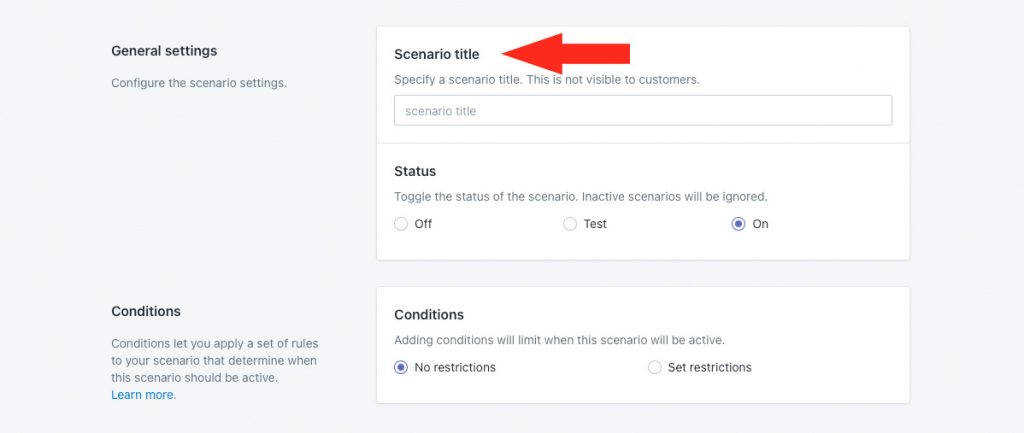
2) Set the Scenario status.

You have three (3) settings to choose from:
Off – The Scenario and its conditions will be ignored. Shipping methods assigned to the Scenario will not be displayed at checkout, even in Sandbox mode.
Test – Shipping methods assigned to the Scenario will only be displayed at checkout when you use ‘Intuitive’ on the checkout page.
If you’re using Shopify, enter ‘Intuitive’ as either the customer’s first or last name.
If you’re using BigCommerce, enter ‘Intuitive’ in the optional address field for ‘Apartment/ Suite/ Building’.
On – Shipping methods assigned to the Scenario will be displayed at checkout. This is the default setting.
Conditions
Conditions are rules that restrict when shipping methods assigned to the Scenario are displayed at checkout.
1) Select whether or not conditions should be applied.

You have two (2) settings to choose from:
No restrictions – shipping methods assigned to the Scenario will always be displayed at checkout. This is the default setting.
If you choose this setting, skip ahead to Product Filters.
Set restrictions – shipping methods assigned to the Scenario will only be displayed at checkout when the assigned conditions are satisfied.
When you select Set restrictions, additional settings will appear on the screen.
2) If you are setting restrictions, select the Condition match setting.

You have three (3) settings to choose from:
All conditions – all of the conditions being added in Steps 3 to 5 must be satisfied for shipping methods in this Scenario to be displayed at checkout. This is the default setting.
Any condition – at least one of the conditions being added in Steps 3 to 5 must be satisfied for shipping methods in this Scenario to be displayed at checkout.
No conditions – none of the conditions being added in Steps 3 to 5 must be satisfied for shipping methods in this Scenario to be displayed at checkout.
3) Select a condition type.

Condition types are grouped into categories:
Product Conditions
Product conditions determine if shipping methods assigned to the Scenario will be displayed at checkout based on the products in the cart.
Conditions that look for a numerical value, such as quantity, price and volume, apply to each unique product in the cart. Any item with a Product ID or Variant ID is considered a unique product.
Product tag – shipping methods will be displayed based on the product tag assigned to the product in Shopify.
This condition type is not available for BigCommerce.
Product vendor – shipping methods will be displayed based on the product vendor assigned to the product in Shopify.
This condition type is not available for BigCommerce.
Product title – shipping methods will be displayed based on the product title (product name) assigned to the product in Shopify or BigCommerce.
Product SKU – shipping methods will be displayed based on the SKU assigned to the product in Shopify or BigCommerce.
Product collection – shipping methods will be displayed based on the product collection the product is assigned to in Shopify.
This condition type is not available for BigCommerce.
Product type – shipping methods will be displayed based on the product type the product is assigned to Shopify.
This condition type is not available for BigCommerce.
Product category – shipping methods will be displayed based on the product category the product is assigned to in BigCommerce.
This condition type is not available for Shopify.
Fulfillment service – shipping methods will be displayed based on the fulfillment service the product is assigned to Shopify.
This condition type is not available for BigCommerce.
Product property – shipping methods will be displayed based on the product properties assigned to the product.
This condition type is not available for BigCommerce.
Product quantity – shipping methods will be displayed based on the combined quantity of each unique product in the cart.
Product price – shipping methods will be displayed based on the price of each unique product in the cart.
Product total – shipping methods will be displayed based on the product sub-total for each unique product in the cart.
Product weight – shipping methods will be displayed based on the combined weight of each unique product in the cart.
Product volume – shipping methods will be displayed based on the combined dimensional volume of each unique product in the cart.
Product length – shipping methods will be displayed based on the combined length of each unique product in the cart.
Product width – shipping methods will be displayed based on the combined width of each unique product in the cart.
Product height – shipping methods will be displayed based on the combined height of each unique product in the cart.
Product packing method – shipping methods will be displayed based on the packing method assigned to the product in Intuitive Shipping.
Product free shipping – shipping methods will be displayed based on the free shipping eligibility assigned to the products in Intuitive Shipping.
Product has custom shipping – shipping methods will be displayed based on whether or not the products have been assigned custom shipping costs in Intuitive Shipping.
Product has pieces – shipping methods will be displayed based on whether or not products have had additional pieces assigned to them in Intuitive Shipping.
Customer Conditions
Customer conditions determine if shipping methods assigned to the Scenario will be displayed at checkout based on the available customer information.
Customer conditions look at information added by the customer during checkout, such as city and email address, or assigned to your customer’s profile, such as customer tags, if supported by your eCommerce platform.
Customer tag – shipping methods will be displayed based on the customer tag assigned to the customer in Shopify.
This condition type is not available for BigCommerce.
Customer group – shipping methods will be displayed based on the customer group assigned to the customer in BigCommerce.
This condition type is not available for Shopify.
Postal/ zip code – shipping methods will be displayed based on the postal or zip code entered by the customer at checkout.
Street address – shipping methods will be displayed based on the street address entered by the customer at checkout.
City – shipping methods will be displayed based on the city name entered by the customer at checkout.
Postal box – shipping methods will be displayed based on whether or not the customer has a PO Box in their address.
Company – shipping methods will be displayed based on the company name entered by the customer at checkout.
This condition type is not available for BigCommerce.
Customer name – shipping methods will be displayed based on the first and last names entered by the customer at checkout .
This condition type is not available for BigCommerce.
Email – shipping methods will be displayed based on the email address assigned to the customer in Shopify.
This condition type is not available for BigCommerce.
Telephone – shipping methods will be displayed based on the phone number entered by the customer at checkout.
This condition type is not available for BigCommerce.
Fax – shipping methods will be displayed based on the fax number entered by the customer at checkout.
This condition type is not available for BigCommerce.
Previous Order Count – shipping methods will be displayed based on the previous total number of orders placed by the customer.
This condition type is not available for BigCommerce.
Previous Order Total – shipping methods will be displayed based on the previous total value of orders placed by the customer.
This condition type is not available for BigCommerce.
Order Source – shipping methods will be displayed based on the order source used to create the order, such as ‘checkout’ or ‘draft order’.
This condition type is not available for BigCommerce.
Cart Conditions
Cart Conditions determine if shipping methods assigned to the Scenario will be displayed at checkout based on the entire contents of the cart.
Cart quantity – shipping methods will be displayed based on the combined quantity of all items in the cart.
Cart total – shipping methods will be displayed based on the combined product sub-total (before tax) of all items in the cart.
Cart weight – shipping methods will be displayed based on the combined weight of all items in the cart.
Cart volume – shipping methods will be displayed based on the combined dimensional volume of all items in the cart.
Cart length – shipping methods will be displayed based on the combined length of all items in the cart.
Cart width – shipping methods will be displayed based on the combined width of all items in the cart.
Cart height – shipping methods will be displayed based on the combined height of all items in the cart.
Filtered Cart Conditions
Filtered cart conditions are intended to work with the combination of product conditions and product filters when product filters are set to ‘Match product conditions’.
Let’s say you want to offer free shipping only when a customer orders at least 5 fragile items. To achieve this, you can have a product condition that states Tag equals ‘fragile’, along with a filtered cart condition that states Quantity is greater than or equals ‘5’.
You must also have Product filters set to ‘Match product conditions’.
In this situation, there must be at least 5 items in the cart tagged ‘fragile’ for your free shipping method to be displayed at checkout, regardless of the other products in the cart or the total quantity of items.
The Product filter setting – set to ‘Match product conditions’ – means only products tagged ‘fragile’ can be calculated by the shipping method, which in this example is ‘free’.
Risks When Using Filtered Cart Conditions
Filtered cart conditions are effective when you want to restrict and calculate shipping based on specific products in the cart.
If you don’t include a product condition, a filtered cart condition will behave the same way as a typical whole cart condition. Using the example above, if you do not include the product condition ‘Tag equals fragile’, and only have the filtered cart condition ‘quantity is greater than or equal to 5’, the shipping method will be displayed as long as any product in the cart equals 5 or more.
Even when you do include a product condition, filtered cart conditions will only work as intended when the Product filter setting is set to ‘Match product conditions’. When Product filters are set to either ‘No filters’ or ‘Select product filters’, calculation errors will occur.
Filtered cart quantity – shipping methods will be displayed based on the combined quantity of items in the cart that satisfy the product conditions in the same Scenario.
Filtered cart total – shipping methods will be displayed based on the sub-total of items in the cart that satisfy the product conditions in the same Scenario.
Filtered cart weight – shipping methods will be displayed based on the combined weight of items in the cart that satisfy the product conditions in the same Scenario.
Filtered cart volume – shipping methods will be displayed based on the combined volume of items in the cart that satisfy the product conditions in the same Scenario.
Filtered cart length – shipping methods will be displayed based on the combined length of items in the cart that satisfy the product conditions in the same Scenario.
Filtered cart width – shipping methods will be displayed based on the combined width of items in the cart that satisfy the product conditions in the same Scenario.
Filtered cart height – shipping methods will be displayed based on the combined height of items in the cart that satisfy the product conditions in the same Scenario.
Delivery Conditions
Delivery conditions determine if shipping methods assigned to the Scenario will be displayed at checkout based on the delivery preference selected by the customer.
Delivery distance – shipping methods will be displayed based on the distance between your store location and the customer’s address.
Delivery day of the week – shipping methods will be displayed based on the delivery day of the week selected by the customer at checkout.
This condition type is not available for BigCommerce.
Delivery date – shipping methods will be displayed based on the delivery date selected by the customer at checkout.
This condition type is not available for BigCommerce.
Delivery time – shipping methods will be displayed based on the delivery time of day selected by the customer at checkout.
This condition type is not available for BigCommerce.
Delivery type – shipping methods will be displayed based on the delivery type selected by the customer at checkout, such as ‘shipping’, ‘local delivery’, or ‘store pickup’.
This condition type is not available for BigCommerce.
Same Day Conditions
Same day conditions determine if shipping methods assigned to the Scenario will be displayed at checkout based on the current day, date and time at the moment shipping is calculated by Intuitive Shipping.
Current day of the week – shipping methods will be displayed based on the day of the week at the time of checkout.
Current date – shipping methods will be displayed based on the date at the time of checkout.
Current time – shipping methods will be displayed based on the time of day at the moment of checkout.
Condition Groups
Condition groups determine if shipping methods assigned to the Scenario will be displayed at checkout based on the selected condition group.
4) Select a condition logic.

You have up to eight (8) settings to choose from:
Equals – The actual value at checkout must match exactly with the condition value entered in Step 5.
Does not equal – The actual value at checkout can be anything except the condition value entered in Step 5.
Contains – The actual value at checkout must contain the condition value entered in Step 5.
Does not contain – The actual value at checkout cannot contain the condition value entered in Step 5.
Greater than – The actual value at checkout must be more than the condition value entered in Step 5.
Greater than or equals – The actual value at checkout must either match or be more than the condition value entered in Step 5.
Less than – The actual value at checkout must be less than the condition value entered in Step 5.
Less than or equals – The actual value at checkout must either match or be less than the condition value entered in Step 5.
Starts with – The actual value at checkout must start with the condition value entered in Step 5.
Ends with – The actual value at checkout must end with the condition value entered in Step 5.
5) Enter the condition value.
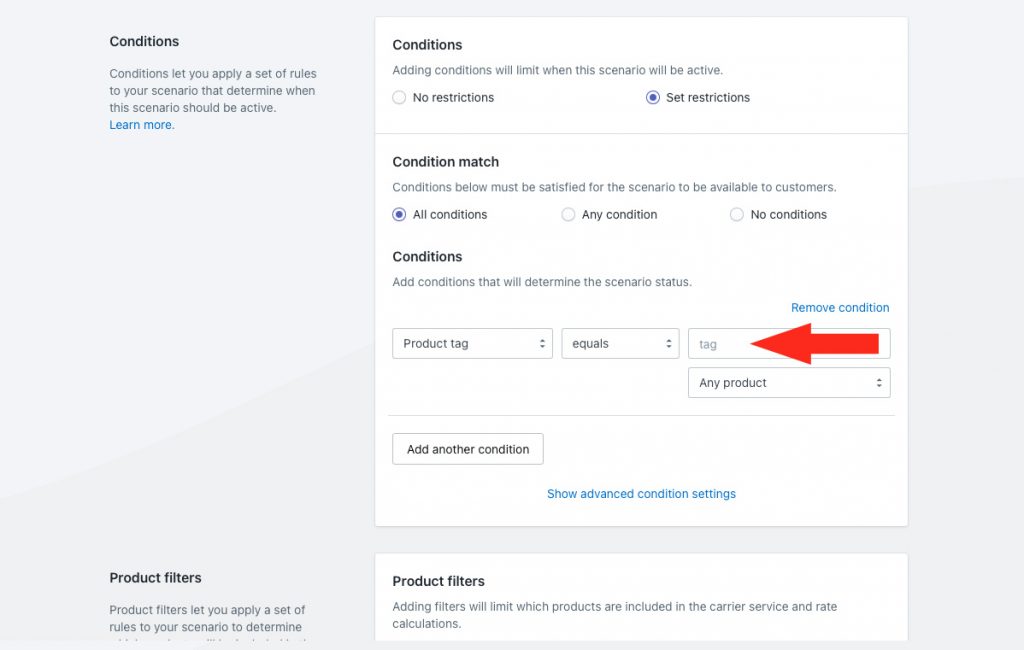
6) To add more conditions, click the Add another condition button, then repeat Steps 3 to 5 for each additional condition.

When assigning product conditions, each product condition includes an additional setting that is neither required nor displayed for other conditions types. If you have not added any product conditions to the Scenario, skip ahead to Step 8. If you have added product conditions, continue to Step 7.
7) Select the appropriate product setting.

You have three (3) settings to choose from:
Any product – At least one product in the cart must satisfy the product condition.
All products – All products in the cart must satisfy the product condition.
No products – None of the products in the cart must satisfy the product condition.
Additional settings are available for advanced condition restrictions. If you have products with custom shipping prices, you can configure Intuitive Shipping to exclude or include all of those products in the conditions check.
If you are not using custom shipping prices for any of your products, skip ahead to Product Filters.
8) Click Show advanced condition settings.
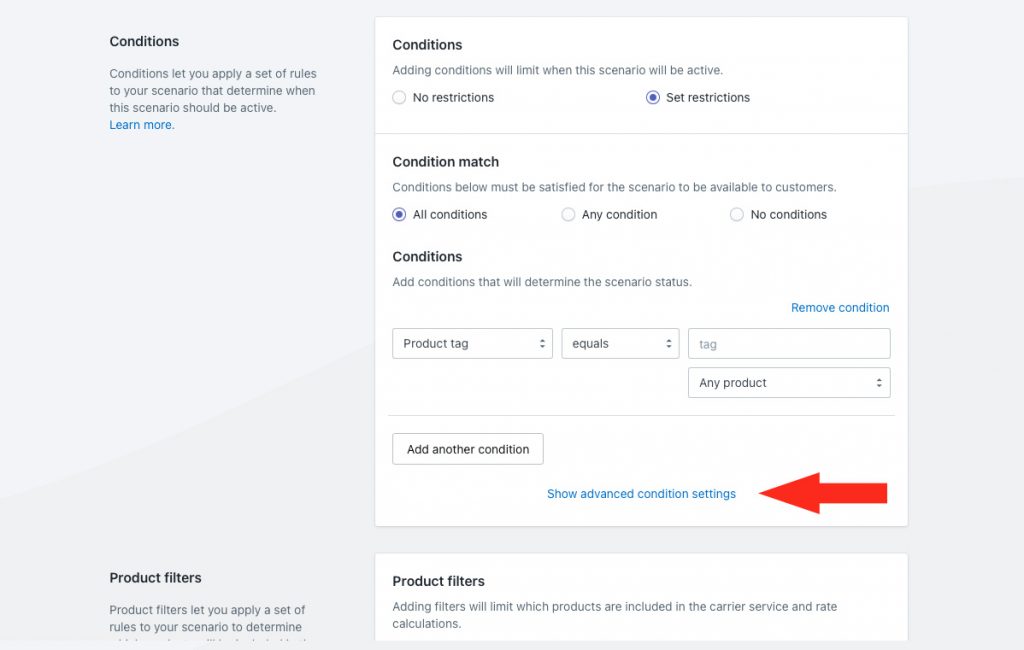
9) Select whether products with custom shipping prices should be included or excluded in the conditions check.

You have two (2) settings to choose from:
Include in conditions – all products with custom shipping prices will be included in the condition check.
For example, if you have a Scenario with a cart condition that states Quantity is greater than or equals 10, products that have their own custom shipping prices will count towards the minimum of 10.
Exclude from conditions – products with custom shipping prices will be excluded from the condition check.
Using the same example, products that have their own custom shipping prices will not count towards the minimum of 10.
Product Filters
Product filters let you decide which products should or should not be included in the shipping method rate calculation.
In the majority of cases, product filtering will match any product conditions you have added to the Conditions section. However, there are certain situations when unique product filters – or no filters may be needed.
To restrict when shipping methods are displayed based on the products in the cart, use product conditions in the Conditions section.
1) Choose how product filters should be applied.

You have three (3) settings to choose from:
No filters – every product in the cart is included in rate calculation performed by the shipping method assigned to this Scenario, regardless of product conditions.
If you select this option, skip ahead to Save Your Settings
Set product filters – only products that meet the filter match settings in Steps 2 to 6 will be included in the rate calculation performed by the shipping method assigned to this Scenario, regardless of any product conditions.
When you select Set product filters, additional settings will appear on the screen. If you choose this option, continue to Step 2.
Match product conditions – product filters will match any product conditions set in the Conditions section. This is the default setting.
For example, if you added the product condition Product tag equals ‘fragile’, and you selected the ‘Match’ setting, only products tagged ‘fragile’ will be included in the rate calculation performed by the shipping method assigned to this Scenario.
If you added a second product condition Product weight is less than or equals 5 lbs, only products tagged ‘fragile’ that are also 5 lbs or less will be included in the rate calculation.
If you select this option, skip ahead to Save Your Settings
2) If you chose ‘Set product filters’ in Step 1, select the Filter match setting.
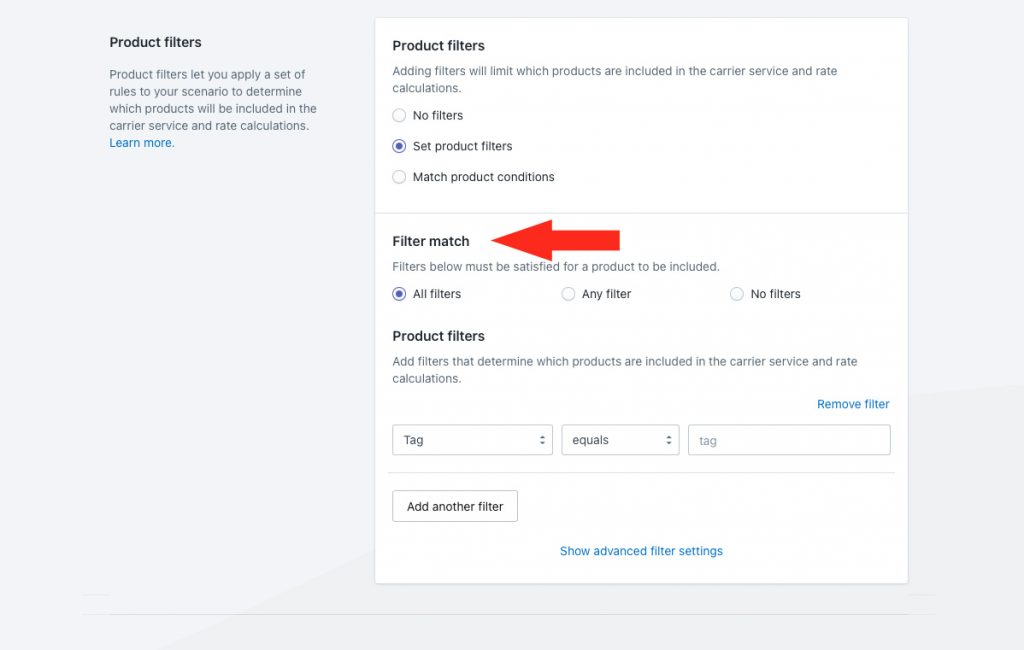
You have three (3) settings to choose from:
All filters – products must satisfy all of the product filters being applied in Steps 3 to 6 to be included in the rate calculation.
Any filter – products must satisfy at least one of the product filters being applied in Steps 3 to 6 to be included in the rate calculation.
No filters – products must satisfy none of the product filters being applied in Steps 3 to 6 to be included in the rate calculation.
3) Select a product filter type.

You have several settings to choose from:
Tag – products will be filtered by the product tag assigned to them in Shopify.
This filter type is not available for BigCommerce.
Vendor – products will be filtered by the vendor assigned to them in Shopify.
This filter type is not available for BigCommerce.
Title – products will be filtered by the title (product name) assigned to them in Shopify or BigCommerce.
SKU – products will be filtered by the SKU assigned to them in Shopify or BigCommerce.
Collection – products will be filtered by the collection they are assigned to in Shopify.
This filter type is not available for BigCommerce.
Type – products will be filtered by the Type they are assigned to in Shopify.
This filter type is not available for BigCommerce.
Category – products will be filtered by the category they are assigned to in BigCommerce.
This filter type is not available for Shopify.
Fulfillment service – products will be filtered by the Fulfillment service they are assigned to in Shopify.
This filter type is not available for BIgCommerce.
Property – products will be filtered by the product Property attribute assigned to them.
This filter type is not available for BigCommerce.
Quantity – products will be filtered by the quantity of each unique product in the cart.
Price – products will be filtered by the price of each unique product in the cart.
Total – products will be filtered by the sub-total of each unique product in the cart.
Weight – products will be filtered by the combined weight of each unique product in the cart.
Volume – products will be filtered by the combined volume of each unique product in the cart.
Length – products will be filtered by the combined length assigned to products in Intuitive Shipping.
Width – products will be filtered by the combined width assigned to products in Intuitive Shipping.
Height – products will be filtered by the combined height assigned to products in Intuitive Shipping.
Packing method – products will be filtered by the packing method assigned to the products in Intuitive Shipping.
Free shipping – products will be filtered by the free shipping eligibility assigned to products in Intuitive Shipping.
Has custom shipping – products will be filtered by whether or not they have custom shipping costs assigned to them in Intuitive Shipping.
Has pieces – products will be filtered by whether or not they have additional pieces assigned to them in Intuitive Shipping.
4) Select a product filter logic.

You have up to eight (8) settings to choose from:
Equals – the actual product value must match exactly with the product filter value entered in Step 5.
Does not contain – the actual product value cannot contain the product filter value entered in Step 5.
Greater than – the actual product value must be more than the product filter value entered in Step 5.
Greater than or equals – the actual product value must either match or be more than the product filter value entered in Step 5.
Less than – the actual product value must be less than the product filter value entered in Step 5.
Less than or equals – the actual product value must either match or be less than the product filter value entered in Step 5.
Starts with – the actual product value must start with the product filter value entered in Step 5.
Ends with – the actual product value must end with the product filter value entered in Step 5.
5) Enter the product filter value.

6) To add more product filters, click the Add another filter button, then repeat Steps 3 to 5 for each additional product filter.

Additional settings are available for advanced product filtering. If you have products with custom shipping prices, you can configure Intuitive Shipping to exclude or include all of those products in the product filtering
If you are not assigning custom shipping prices to any of your products, skip ahead to Save Your Settings. Otherwise, continue to Step 7.
7) Click Show advanced filter settings.
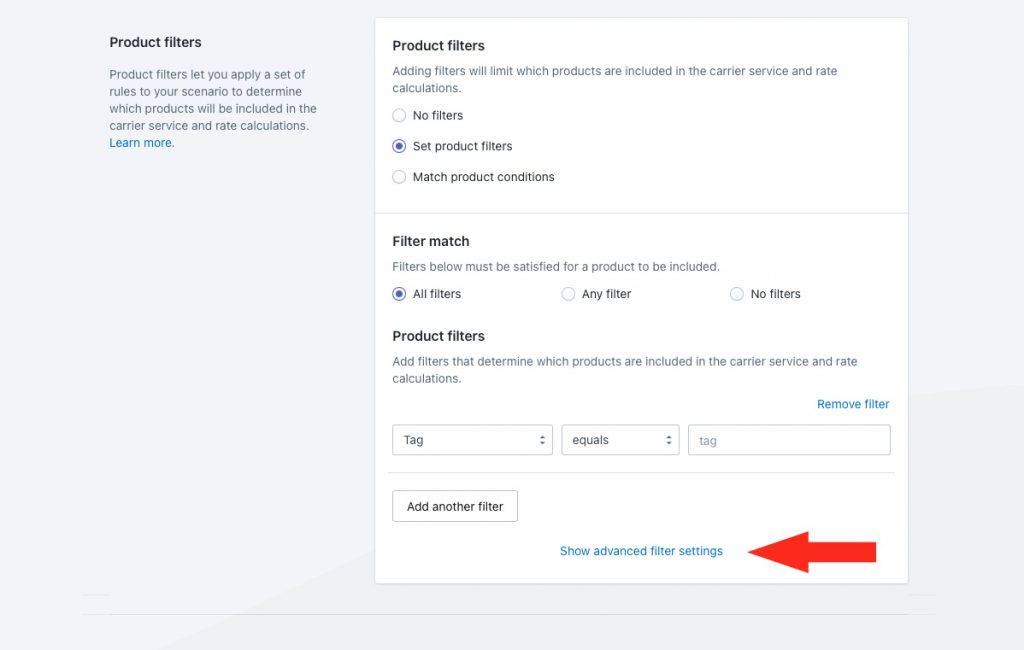
8) Select a custom shipping setting.

You have two (2) settings to choose from:
Exclude from calculation – all products with custom shipping prices will be excluded from the rate calculation. This is the default setting.
For example, if you have a custom service shipping method that calculates shipping based on cart quantity – meaning, the number of items in the cart determines the shipping cost, products that have their own custom shipping prices will not count towards the quantity that determines the cost.
Alternatively, if you have a parcel service shipping method that calculates live rates from a carrier, products that have their own custom shipping prices will not be included in the rate calculation – meaning, their weight will not be added to the total weight of the shipment.
Include in calculation – all products with custom shipping charges will be included in the rate calculation.
Using the same examples, products that have their own custom shipping prices will count towards the quantity that determines the cost or will have their weight included in the total weight of the shipment, depending on which type of shipping method you have.
Save Your Settings
1) Click the Save button to save your Scenario.

What’s Next:
Create a custom service shipping method or a parcel service shipping method.
